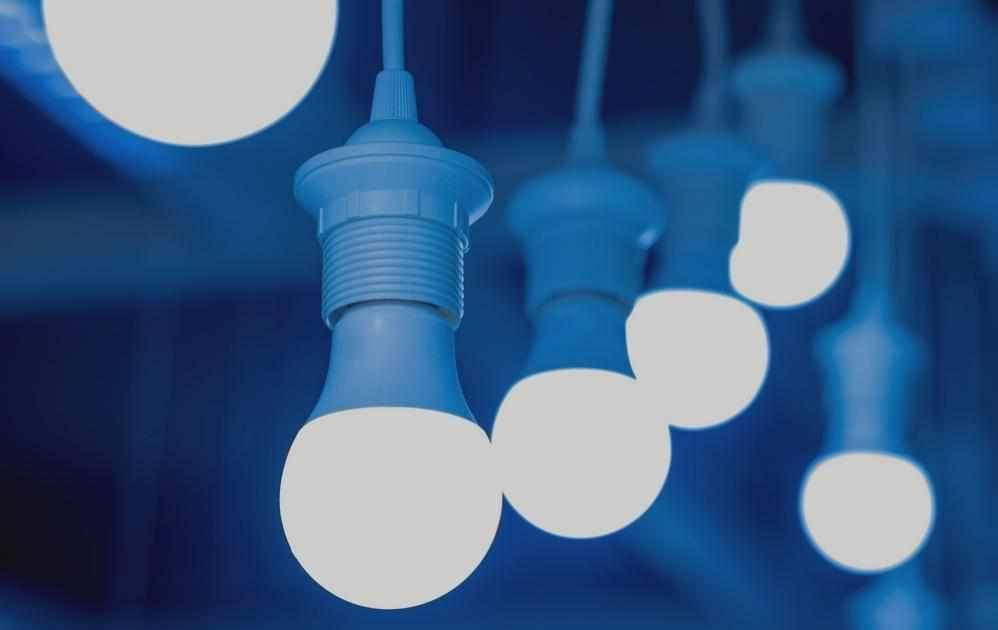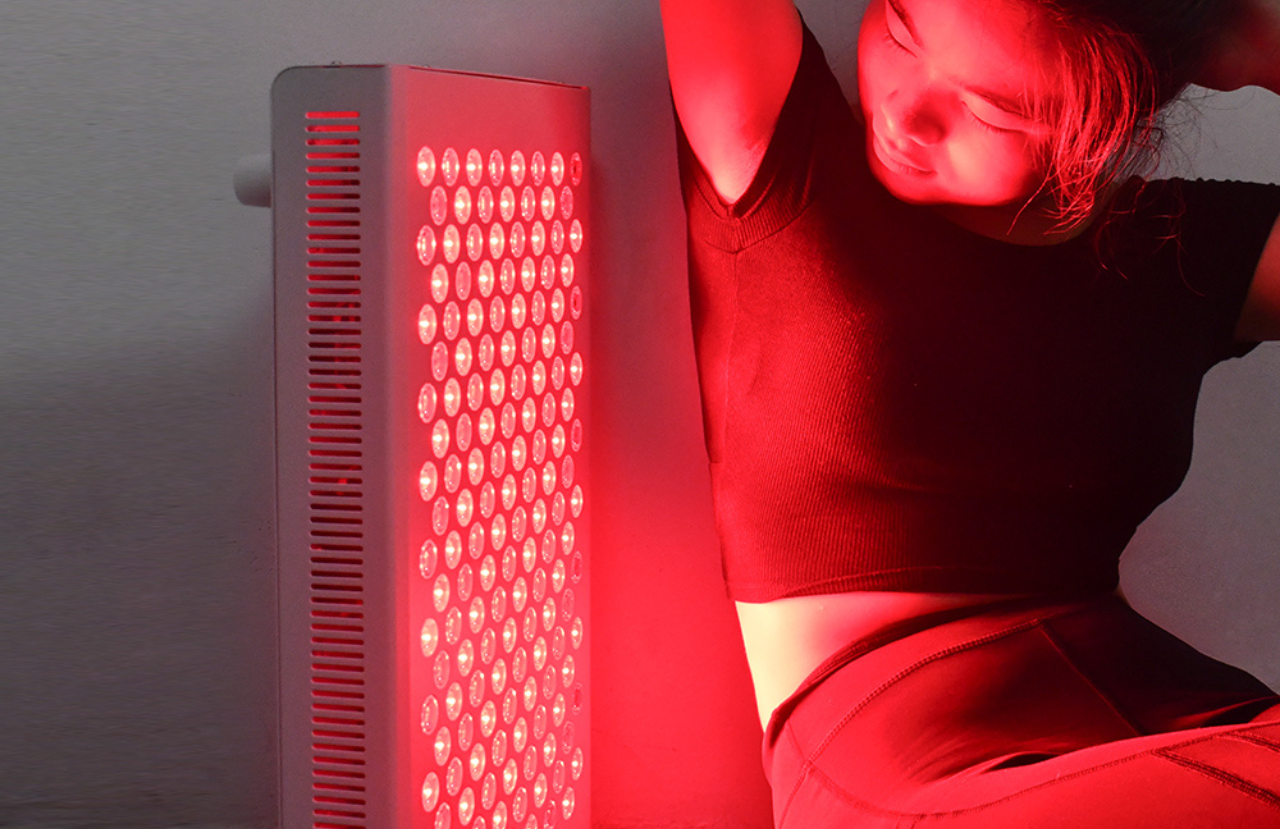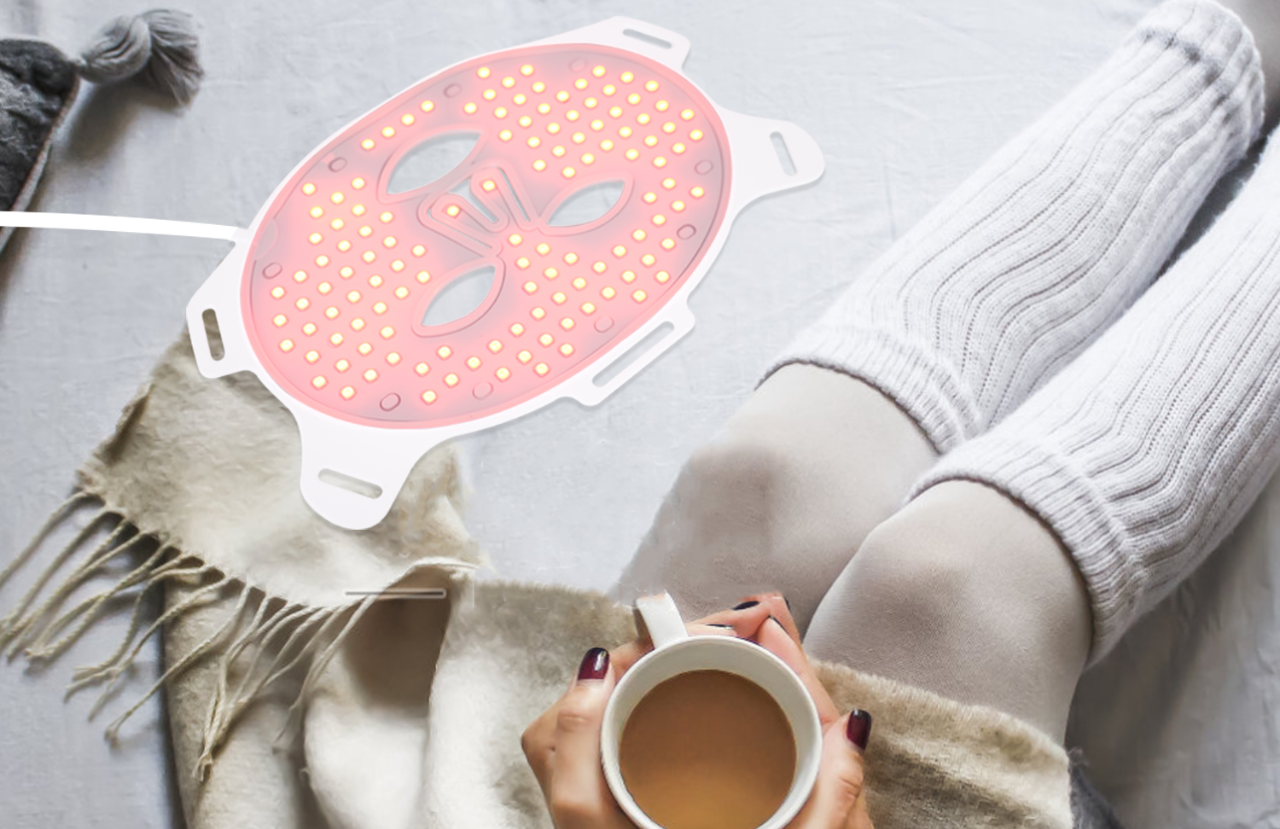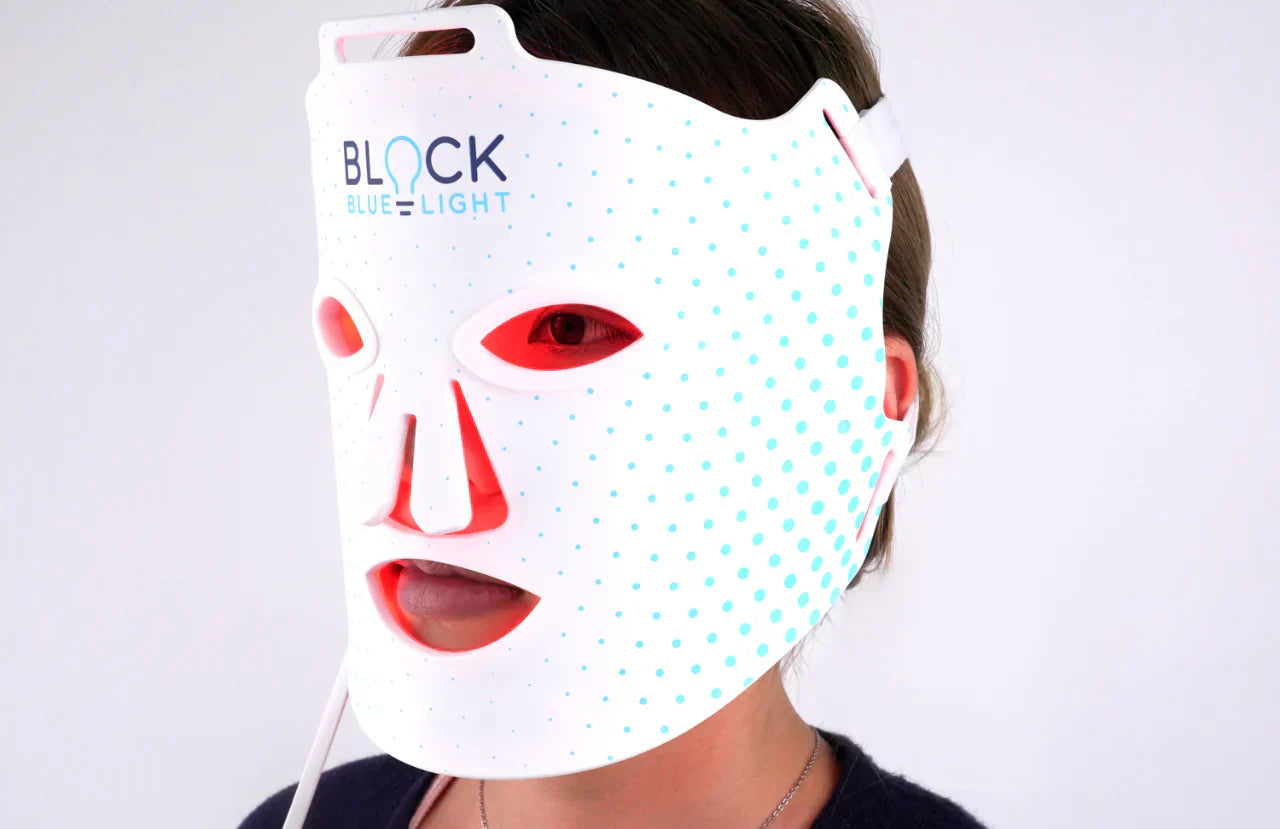"Lighting is everything.” It's a line you've probably heard photographers or models quoting. However, we're light-sensitive beings so lighting really is everything to everyone!
Children spend up to 7 hours in school classrooms under artificial lighting, while adults can spend 9-10 hours a day in harsh office lighting. If we add up all the hours we spend working indoors over a lifetime, our exposure to these intense artificial light sources is alarming. Not to mention the bright screens we constantly stare at.
Sadly, most people are unaware that lighting in our school, work and home environments has a huge impact on health and productivity.
In this article, we'll shine a light on the problems with modern lighting and what you can do to avoid the risks.
From Incandescent to Fluorescent and LED: How Modern Lighting Works

Before we dive in, you need to understand a bit about the history of artificial lighting and how it works.
The only light our ancestors had was sunlight, moonlight and firelight. It allowed them to work from sunrise to sunset and spend evenings winding down.
That all changed in the late 1800s.
Thomas Edison invented the first electric light bulbs in the 1870s -- known as incandescent bulbs. This bulb works by resisting electricity as it flows through an internal filament, heating it and radiating light (and plenty of heat).
Unfortunately, these lights were inefficient, wasted energy and had short life spans. Incandescent bulbs have been largely phased out due to the advancements in technology, but they transformed our world in a big way.
The lighting solutions used today are predominantly fluorescent and LED lights. They're long-lasting and more efficient.
Fluorescent lamps come in two forms -- old-school fluorescent tubes and compact fluorescent lights (CFLs). They consist of a phosphorous-coated glass tube containing liquid mercury. When an electric current runs through the tube, it excites the mercury which vaporizes and produces UV-light. The phosphorous coating then absorbs the UV-light, and the tube starts to glow -- voilà, visible white light!
CFLs are more efficient than the old fluorescent tubes as they contain up to six small curved fluorescent tubes.
Finally, light-emitting diodes (LEDs) are the most eco-friendly bulbs on the market nowadays. They contain semiconductor diodes which emit light energy when electricity flows through them. LEDs last for ages, they save electricity and are super durable.
In Australia, the transition to more eco-friendly fluorescent and LED lighting will result in an estimated 28 million ton reduction in greenhouse gas emissions between 2008 and 2020 (1). Wow!
Unfortunately, these modern lights have a dark side too. It sounds hard to believe, but let us explain…
The Problems with Modern Lighting: Flicker, Colour Temperature and Toxicity
Do you experience headaches and sore eyes from sitting under harsh office lighting? Do you feel jittery surrounded by bright lights?
You're not the only one. The intensity and colour of fluorescent and LED lighting can play havoc with our nervous system, mood and health.
Flicker
Conventional fluorescent and LED light bulbs fluctuate in brightness many times per second because the alternating current electricity is not constant. This results in "flicker". Another cause of flicker is CFL or LED lights working on a dimmer switch without enough electrical resistance.
In the past, flicker was noticeable and sometimes even audible. Due to the improvement in lighting technology, visible flicker has reduced and is now largely invisible to the eye because the fluctuations happen so rapidly.
However, even if it's not consciously noticeable, flicker can still be picked up by the brain and it irritates the nervous system (2). The pupil of the eye should contract in response to bright light and dilate in dim light. However, with the extremely rapid dimming and brightening of high-frequency flicker, the pupils could remain dilated (3).

Flicker from CFLs and LEDs may lead to (3, 4, 5, 6):
- Eyestrain
- Double vision
- Headaches
- Migraines
- Stress
- Poor concentration
- Reduced visual task performance
- Fatigue
- Repetitive behaviour in autistic people
A 2010 study found that people in an office setting with non-visible flicker from conventional fluorescent lights had heightened central nervous system arousal and lower performance accuracy (7).
Interestingly, conventional LED light bulbs may be even more irritating to the eyes and brain than fluorescent bulbs. Even though not visible, LEDs may dim by 100% with each flicker, whereas fluorescents only dim about 35% per flicker (8).
Flicker is particularly troublesome for people with increased sensitivity to light -- like migraine and epilepsy sufferers.
Colour Temperature
In the mid-1800s, a man named William Kelvin began to notice the changes in the colour of a carbon block as it heated up. As the temperature climbed, the colours changed from red to orange to white to almost bluish. This is the origin of the colour temperature scale, measured in Kelvins (K).
The warmer colours of red, orange and yellow are low on the colour temperature scale (1000 - 3000K) and "cool" bright colours of white and blue are high on the colour temperature scale (3500 - 7000K). Sounds a bit counter-intuitive, right?!
Light high on the colour temperature scale emits significant amounts of artificial blue light, which signals the brain that it's daytime and halts the production of our sleep hormone melatonin. It does this by stimulating melanopsin, a photosensitive pigment in the retina that suppresses melatonin production (9).

One study found that high colour temperature light of 6700K negatively impacts the ability to reach stage four slow-wave, deep sleep (10). This is the vital reparative stage of sleep!

For more information on the effects of artificial light on sleep and health, you can read our blog here.
However, it's not just our sleep that's affected.
Research has found that high colour temperature light stimulates our brain's arousal centre via non-visual photoreceptors in the eye. It impacts our nervous system and stress response, affecting stress hormones, muscle tension, heart rate variability, blood pressure, body temperature regulation and sleep (11, 12).
It needs more research, but spending day after day under these artificial lights could be triggering the nervous system and playing a role in the rising levels of learning, attention and behavioural problems among children.
A study in 2011 also found evidence that the transition from incandescent to fluorescent lighting had a big impact on eye health (1). Fluorescent lighting above 4000K is dangerous for the eye, and at 6000K it can cause damage to the retina.
Conventional LEDs that emit high-intensity blue light also have a major impact on eye health. One study found that LED light can damage the retina of the eye, which is becoming an epidemic as more people spend their time in front of LED-lit screens and under LED lights (13).
Mercury Toxicity from Florescent Lights

Unfortunately, fluorescent lights and CFLs contain toxic mercury which makes them risky.
Breaking light bulbs is inevitable, but with fluorescents it means heavy metal exposure. Most people don't realize that increased ventilation, a careful clean-up process and safe disposal is ESSENTIAL in the case of a broken CFL. Many will use a vacuum and -- even worse -- pick up the bulb with bare hands.
Even at low levels, mercury is a neurotoxin and has been linked to health problems like neurological symptoms, poor motor functions, insomnia and headaches (14).
An alarming 2012 study found that broken CFL bulbs are a public health concern (15). Four hours after the initial breaking of the CFL bulb the indoor concentration of mercury vapour still exceeded the Reference Exposure Limit (REL).
Imagine having small children and animals around who may not only inhale the vapour but make contact with the bulb! It's a disaster waiting to happen.
UV radiation from Compact Florescent Bulbs
Hairline cracks in the phosphor-coated glass tubing of CFLs are common but hard to spot -- and can expose you to unsafe levels of UV radiation.
Research done by Stony Brook University in 2012 found that healthy skin cells exposed to UV rays from CFLs -- purchased from local stores -- experienced UV radiation damage (16). In comparison, old incandescent light bulbs of the same intensity had no effect.
If you think about spending hours under these lights, the impact could be huge! It may be especially harmful to people with UV-light sensitive conditions like solar urticaria and lupus.
Long-term exposure to UV light may also damage the eyes and lead to cataracts, macular degeneration and other vision problems (3).
Indoor Lighting Solutions to Improve Sleep and Overall Health
The good news is, just a few changes to your evening lighting environment can reduce risks and improve health and wellness. BlockBlueLight lighting solutions make it as easy as flicking a switch!
1. Avoid Fluorescent and Conventional LED Lights Altogether
As we've outlined, fluorescent and conventional LED lights have a whole range of issues. Not only do they expose you to flicker, using them puts you at risk for eye damage as well as mercury and UV radiation exposure.
Can we agree to avoid these bulbs?
Specifically designed LED bulbs are the best option for lighting, BUT only if you choose the correct kind...
2. Choose Flicker-Free, Low Colour Temperature (Blue Light Free) Light Bulbs
When choosing LED light bulbs for optimal health and sleep, you want to look for bulbs on the lower end of the colour temperature scale.
Avoid any type lights that produce artificial blue light. Go for bulbs with less blue light energy and more orange and red tones -- this will reduce the impact on your circadian rhythm and relax your nervous system.
A 2013 study found that people were more relaxed in warm, low colour temperature lighting (17).
Another interesting study found that adults who were exposed to low, warmer light were more likely to offer praise to others, resolve conflicts with collaboration and donate time to unpaid volunteering than those under high colour temperature light (18).
Additionally, you want bulbs that state they are flicker-free.
Enter our Sweet Dreams Light Bulbs. We've developed them using proprietary spectrum technology to eliminate all the downfalls of conventional LED lights.
Our warm orange LED bulbs are efficient and durable, don’t emit ANY blue light and are 100% flicker-free. They have a low colour temperature of 1780K and are the ONLY kind of LED that has the blue light spectrum removed altogether.
Our light bulbs encourage:
- Healthy sleep-wake cycles
- Good eye health
- Stress-reduction
The Sweet Dreams light bulbs can be used throughout your home and are great for offices where employees work late into the evening. It's not too bright and not too dim, so you can still do work, read and cook.
3. It’s not just the blue. It’s also the green.

The Twilight Bulb has been specially designed to remove 100% of blue AND 100% of green light. Research is now starting to come out showing green light is also impacts on our melatonin production and overall sleep quality.
In response to these findings we have created the Twilight Bedtime Bulb. This is the ideal dim lighting to use before bed in reading lamps, bedrooms, bathrooms, or anywhere you spend your evening hours prior to bed. They utilise the same proprietary spectrum technology to deliver flicker free LED light that has no sleep distrusting blue or green light ensuring optional deep and restful sleep.
4. Choose Light Bulbs with a Low M/P Ratio
 The M/P ratio -- melanopic/photopic ratio -- is a way to measure the melanopsin response and the amount of perceived brightness from a bulb.
The M/P ratio -- melanopic/photopic ratio -- is a way to measure the melanopsin response and the amount of perceived brightness from a bulb.
You want a light bulb with a lower M/P ratio so it has good illumination but won't disrupt your sleep.
The M/P ratio of our Sweet Dreams and Twilight Bedtime Bulbs is 0.33+/0.02. You'll get enough illumination without the intense light that will impact sleep or irritate your nervous system.
5. Use Red LED Night Lights
For quality sleep, it's important to avoid switching on any bright lights after sunset and especially in the middle of the night.
Our red LED night lights are a convenient and healthy way to get light after dark. They emit very low colour temperature red light and absolutely NO blue or green light. It plugs straight into the wall and has an on-off switch.
These night lights are useful for babies and children who don't want to go to sleep in complete darkness. They're also great for use after dark in all rooms, bathrooms and hallways to help you navigate while avoiding artificial blue light exposure.
6. Keep a Red Light Torch on Hand


If you need light late at night or during the early hours, don't reach for the flashlight on your smartphone or your bedside lamp! These are high in blue light and will disrupt sleep.
Our Red light Twilight Torch is the best light to use to get around at night. It is pocket-sized and contains 9 LEDs that emit only red light. It's bright enough to see what you're doing while not disrupting night time melatonin production.
Each member of your family should have a red light Twilight Torch, so they can easily navigate around at night without any need to turn on harmful bright lights.
Use it to check on your baby or child in the night, read books, take it camping with you and much more.
7. If in Doubt, Use Blue Light Blocking Glasses


If you don't have control over the room lighting you're exposed to -- it can be impossible in certain settings, like a shopping mall or hotel room -- we suggest using our blue light blocking glasses for protection.
Even if you have all your lighting under control by using flicker free and blue light free lighting, your still going to be looking at phone screens, watching TV etc. This is where you need to use blue blocking glasses to provide complete protection.
Research has shown that blocking out blue light encourages melatonin production and improves sleep and mood (19). A 2019 study also found that removing the blue wavelength component of light protects the retina of the eye (20).
We have stylish blue light blocking glasses offering various levels of protection. Orange-tinted and red-tinted glasses are available and will protect you from screens and harsh indoor lighting.
They are designed to remove 100% of blue light and are perfect for use while working, studying, using digital devices and watching movies at night. We've even designed some to fit over your prescription frames.
Final Thoughts
The impact of indoor lighting is more important than most people think. As we've outlined, the consequences to our performance, eyesight, sleep, mood and well-being can be huge.
Fortunately, this knowledge allows us to remove the negative aspects of lighting and improve our overall health. The tips outlined here will help you to optimize your lighting environment safely!
Resources
- Walls et al. (2011). Eye disease resulting from increased use of fluorescent lighting as a climate change mitigation strategy. Available at: https://www.ncbi.nlm.nih.gov/pmc/articles/PMC3222423/
- Lu et al. (2012). Alerting and orienting of attention without visual awareness. Available at: https://www.ncbi.nlm.nih.gov/pubmed/22512841
- Chen and Zhang. (2014). Which lamp will be optimum to eye? Incandescent, fluorescent or LED etc. Available at: https://www.ncbi.nlm.nih.gov/pmc/articles/PMC3949479/
- Rider et al. (2012). Risk assessment for LED lighting flicker. Available at: https://www.researchgate.net/publication/273660125_Risk_assessment_for_LED_lighting_flicker
- Why CFL's aren't such a bright idea. (2014). Available at: https://www.psychologytoday.com/us/blog/mental-wealth/201409/why-cfls-arent-such-bright-idea
- Colman et al. (1976). The effects of fluorescent and incandescent illumination upon repetitive behaviours in autistic children. Available at: https://link.springer.com/article/10.1007%2FBF01538059
- Küller et al. (1998). The impact of flicker from fluorescent lighting on well-being, performance and physiological arousal. Available at: https://www.ncbi.nlm.nih.gov/m/pubmed/9557586/
- Eco-friendly LED light bulbs found to cause increase in headaches. (2017). Available at: https://www.naturalnews.com/2017-08-03-eco-friendly-led-light-bulbs-found-to-cause-increase-in-headaches.html
- Abhishek et al. (2019). Melatonin suppression is exquisitely sensitive to light and primarily driven by melanopsin in humans. Available at: https://onlinelibrary.wiley.com/doi/abs/10.1111/jpi.12562
- Kozaki et al. (2005). Effect of color temperature of light sources on slow-wave sleep. Available at: https://www.ncbi.nlm.nih.gov/m/pubmed/15840951
- Hollwich and Dieckhues. (1980). The effect of natural and artificial light via the eye on the hormonal and metabolic balance of animal and man. Available at: https://www.ncbi.nlm.nih.gov/m/pubmed/6255392/
- Yasukouchi et al. (2005). Non-visual effects of the color temperature of fluorescent lamps on physiological aspects in humans. Available at: https://www.ncbi.nlm.nih.gov/m/pubmed/15684542/
- Jaadane et al. (2015). Retinal damage induced by commercial light emitting diodes (LEDs). Available at: https://www.ncbi.nlm.nih.gov/pubmed/25863264
- Park and Zheng. (2012). Human exposure and health effects of inorganic and elemental mercury. Available at: https://www.ncbi.nlm.nih.gov/pmc/articles/PMC3514464/
- Sarigiannis et al. (2012). Exposure analysis of accidental release of mercury from compact fluorescent lamps (CFLs). Available at: www.researchgate.net/publication/230618894_Exposure_analysis_of_accidental_release_of_mercury_from_compact_fluorescent_lamps_CFLs/amp
- SBU Study reveals harmful effects of CFL bulbs to skin. (2014). Available at: https://news.stonybrook.edu/newsroom/press-release/general/harmfuleffectsofcflbulbstoskin/
- Park et al. (2013). Effects of color temperature and brightness on electroencephalogram alpha activity in a polychromatic light-emitting diode. Available at: https://www.ncbi.nlm.nih.gov/pmc/articles/PMC3897760/
- Baron et al. (1992). Effects of indoor lighting (illuminance and spectral distribution) on the performance of cognitive tasks and interpersonal behaviors: The potential mediating role of positive affect. Available at: https://link.springer.com/article/10.1007/BF00996485
- Burkhart and Phelps. (2009). Amber lenses to block blue light and improve sleep: a randomized trial. Available at: https://www.ncbi.nlm.nih.gov/pubmed/20030543
- Vicente-Tejedor et al. (2018). Removal of the blue component of light significantly decreases retinal damage after high intensity exposure. Available at: https://www.ncbi.nlm.nih.gov/pmc/articles/PMC5854379/








